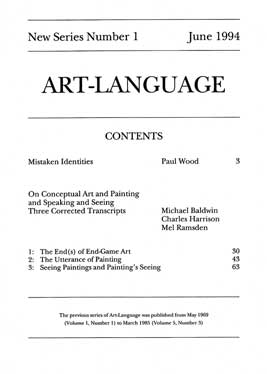

[16] ‘The Utterance of Painting’, Art-Language, New Series No. 1, June, 1994, pp. 43-62 (p. 53).
Par contraste, imputer une « aura » dialogique ou discursive à une œuvre d’art peut sembler lié à la possibilité phénoménologique qu’il existerait quelque chose qui peut être rencontré et reconnu à l’aide des yeux et des sens – quelque chose qui ne ressemble pas vraiment à n’importe quelle autre chose. Il ne s’agit pas là de réduire l’œuvre à un statut empirique d’objet d’épicerie de taille moyenne, mais de reconnaître qu’il est impossible de récuser les limites du littéral, dans la sphère du visuel comme dans celle du verbal, à moins de posséder un sens quelconque de ce qui est littéral et de ce qui ne l’est pas. (Dans le travail du rêve solipsiste, même ceux qui ont un esprit littéral rêvent.) Nous ne nions pas qu’une œuvre d’art se constitue dans et en dehors de matériaux culturels éphémères. Cependant elle est ce qu’elle est en vertu de certains mécanismes et de certaines déterminations intransitifs que leur description n’épuise pas. Plus modestement, on peut suggérer qu’aucune description d’une peinture ou d’une œuvre d’art ne peut l’épuiser. De même, une œuvre d’art conçue d’une certaine façon comme picturale (non-textuelle) ne possèdera pas de caractéristiques signifiantes qui puissent être trouvées dans la description verbale (et ainsi de suite) que l’on fait d’elle, et ceci pour des raisons qui, loin d’être éphémères, appartiennent à la logique sous-estimée du pictural et du textuel.
[16] ‘The Utterance of Painting’, Art-Language, New Series No. 1, June, 1994, pp. 43-62 (p. 53).
In contrast, the imputation of dialogic or discursive ‘aura’ to a work of
art appears somehow to be connected to the phenomenological possibility of
there being some thing to be encountered and learned about with the eyes and
sense – some thing which is not altogether like any other thing. This
is not to reduce the work to some empiricistic status as middle-sized dry
goods, but to recognise that there can be no challenge to the limits of the
literal, in either the visual or verbal spheres, unless there is some sense of what is literal
and what is not. (In solipsistic dreamwork, even the literal-minded are dreaming.)
We do not deny that a work of art is constituted in and out of transient cultural
materials. Yet it is what it is in virtue of certain intransitive mechanisms
and determinations which are not exhausted in any account of it. A more modest
suggestion is that a picture or a work of art will not be exhausted by any
account of it. Similarly a work of art conceived as in some way pictorial
(as non-textual) will not exhibit meaningful characteristics which are recoverable
from verbal descriptions (and so forth) of it, and this for reasons which,
far from being transient, are in the underlaboured logic of the pictorial
and the textual.